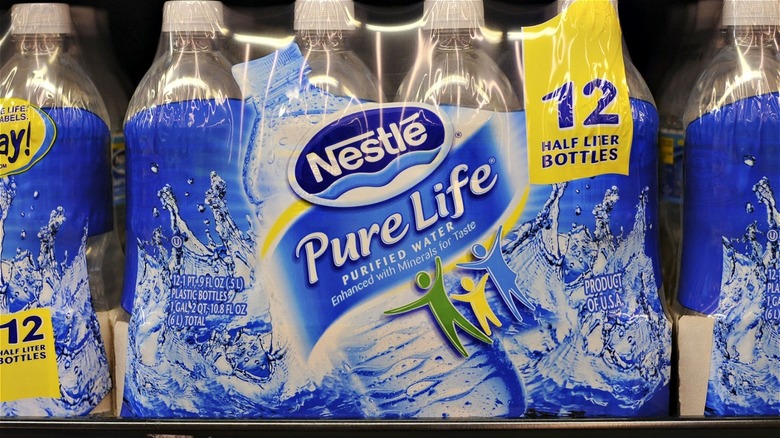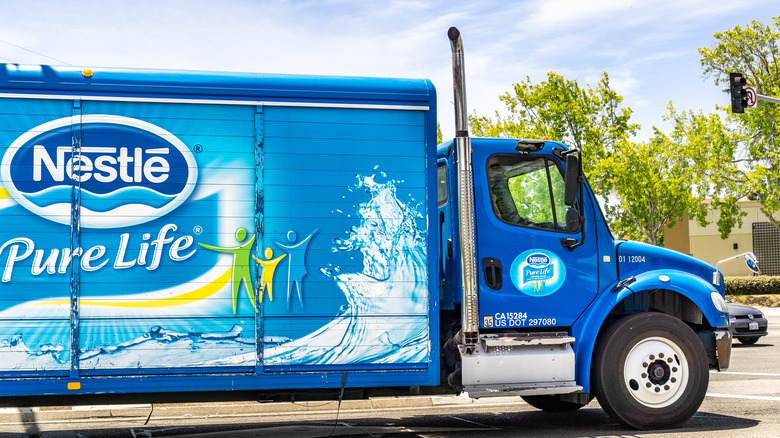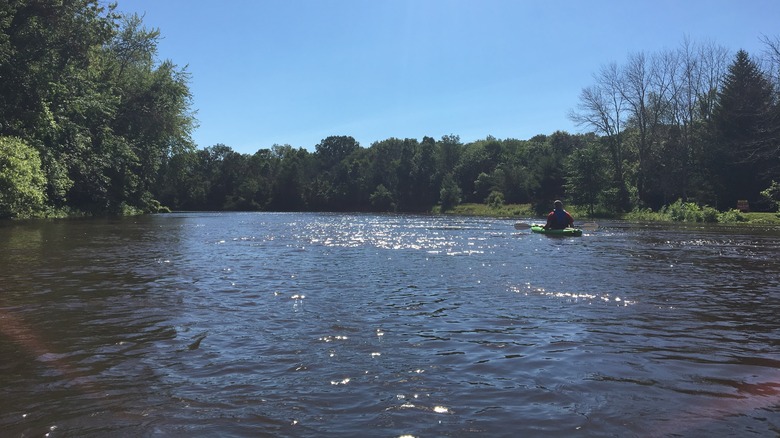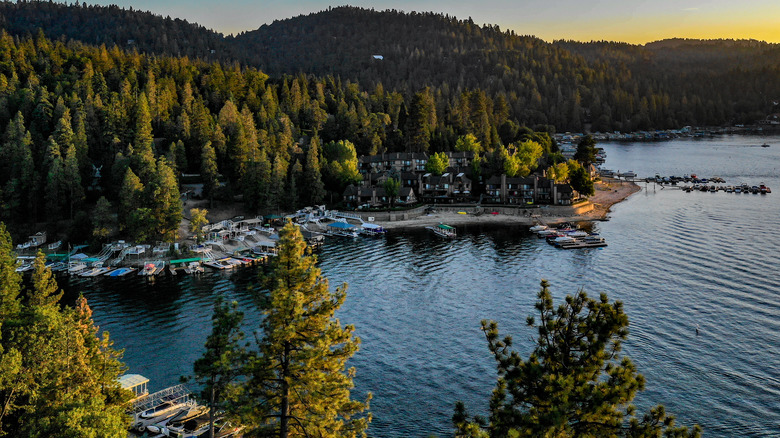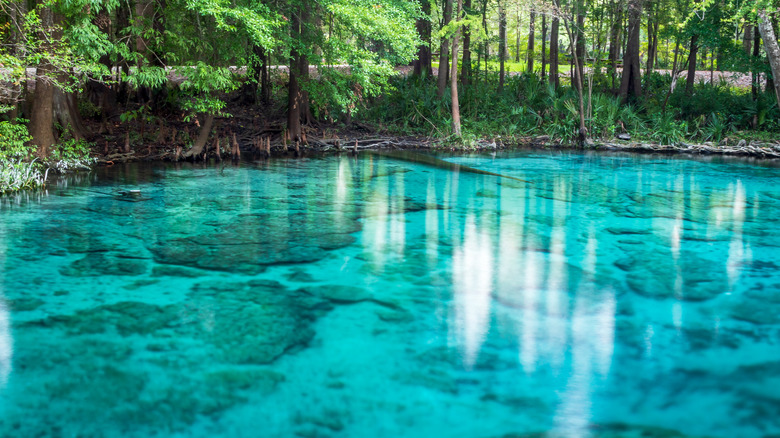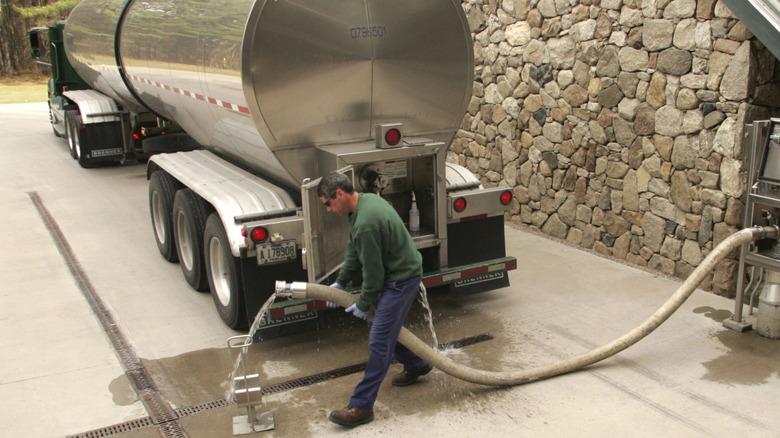Nestle's Water Controversy, Explained
There was a time when giving bottled water a hard pass meant you were doing your bit to help the environment. As Earth-policy.org put it, "More than 17 million barrels of oil are required to produce enough plastic water bottles to meet America's annual demand for bottled water" (via Harvard). But as it turns out, bottled water may be costing us much more than that.
The problem doesn't involve bottled waters like Pepsico's Aquafina, which made waves of their own when it was discovered that their drinks were drawn from tap water, hence the label P.W.S. or "public water source" (via ABC News). Instead, the problem involves waters "bottled at the source," which a third of bottled waters in the U.S. happen to be.
When water is bottled at the source — like in the case of Arrowhead which comes from Strawberry Creek in California, or Ice Mountain and Pure Line which come from Michigan — it is usually drawn from places where it "flow[s] naturally at the land's surface," per The New York Times. But this practice is being questioned by environmentalists, who say this extraction has a steep hidden cost. They say that by extracting ground water to sell, bottled water companies are actually draining natural waterways. Some of this is even being done in states which are already battling water shortages (via Pew).
Nestlé sold its water business, but didn't fix the problem
Arguably the most controversial spring water bottler in the U.S., the company formerly known as Nestlé Waters North America became Blue Triton in April 2021, after being acquired by a private equity firm (via The New York Times). For years, Nestlé/BlueTriton gained access to spring water sites by either obtaining a permit to extract groundwater for itself or buying from smaller companies who extracted the water from the ground.
Depending on the state, the application fee and permit to pump groundwater could cost as little as $115 dollars for a one-time fee (via Florida Springs Institute) or $2,100 per year (via The New York Times). Simply put, the bottler was taking what should be a free resource, putting it in a single-use plastic bottle, and then charging what adds up to be plenty of money. Earth Island says that in 2018, Nestlé sold a staggering $5.4 billion worth of bottled water in the U.S. alone. As environment scientist Robert Knight put it, "The public owns that water. Why should they, or anybody else, be able to take water and profit off of it?"
The company's senior management, however, saw things in a different way.
Water bottlers use the same modus operandi across different states
In an interview with The New York Times in 2017, then chief sustainability officer for Nestlé Waters North America Nelson Switzer said: "Spring water is a very different thing, a precious source. We bring that to the people, that convenience, that ability to reseal, to take it with them, to have it when they need it. That's a very unique idea, a distinction."
But in taking the water from the source and then bottling it, Nestlé/BlueTriton has been accused of depleting the waterways and aquifers of the regions that it operates in. Case in point: In 2017, Nestle pumped more than 130 million gallons of water a year — about 4.8 million bottles of water a day — from wells in northwestern Michigan. In exchange for that, it paid $200 a year in fees. And whenever the company drew water from wells owned by the city, it paid a rate of $3.50 for every thousand gallons.
Jeff Ostahowski, the vice chair of a water conservation group, told The New York Times: "Having anybody take away some of the very best water that should be going into the creeks and the Muskegon River and eventually Lake Michigan, that's a big deal. That Nestlé does it for free? That's just crazy."
Spring water bottlers are accused of depleting aquifers
Michigan is not the only state where Nestle is getting more than its money's worth for the water it pumps.
In California, home to Arrowhead brand spring water, Nestlé/BlueTriton received a draft cease and desist order to stop pumping water out of Strawberry Creek, because it was diverting water resources which flowed into the forests of San Bernardino, located east of Los Angeles. California's Water Resources Control Board called out the company, saying: "During the state's historic drought, the State Water Board's Division of Water Rights received multiple complaints alleging that Nestlé/BlueTriton's continual water diversions depleted Strawberry Creek," and that the company's actions had resulted in "[a] reduced downstream drinking water supply and impacts on sensitive environmental resources" (via The New York Times).
As Michael O'Heaney, executive director of a Berkeley-based environmental group, remarked: "Should we really be pulling water out of a national forest to stick in plastic bottles to sell at a significant markup?"
Groundwater use from the Florida aquifer is up 400 percent
The same scenario is playing out in Florida's Ginnie Springs, one of several hundred waterways that taps into the freshwater Florida Aquifer. Nestlé/BlueTriton was hoping to get government permission to eke out more than 4 million gallons of Florida spring water a day. One of the state's water management districts has already received more than 18 thousand comments, urging the regional water body to veto Nestlé/BlueTriton's request — and with good reason. The Florida Springs Institute says that while groundwater use from the Florida Aquifer went up by over 400% between 1950 and 2010, flows in the Santa Fe River and its springs decreased by roughly 30%.
Floridians like Risa Wray, who stand to make money off deals with Nestlé/BlueTriton, have stood on the side of the food conglomerate, saying: "We believe that protecting this land and using the spring for bottled water is the best option for ensuring the long-term sustainable use of this property."
But others who disagree have written to the regional water board to express their thoughts. "Florida's water needs to be protected. We need clean drinking water and taking so much more water out of Ginnie [Springs] will stress the supply to the Santa Fe River," one Jacksonville resident wrote.
Nestle/BlueTriton has said it is a 'good steward of the environment'
Meanwhile, BlueTriton's current owner insists that the brand has done nothing wrong. In a statement sent to The New York Times, the private equity group said: "For more than 125 years, BlueTriton Brands and its predecessors have sustainably collected water from Arrowhead Springs in Strawberry Canyon," and that they are proud of "being good stewards of the environment, while providing an excellent product loved by Californians."
Nestlé/BlueTriton also has the support of certain industry groups. The International Bottled Water Association, for instance, has echoed its members' claims, saying: "When a bottled water company decides to build a plant, it looks for a long-term, sustainable source of water and the ability to protect the land and environment around the source and bottling facility" (via Pew). But environmentalists aren't buying that, and they appear determined to keep spring water bottlers like BlueTriton from going too far before it's too late.
